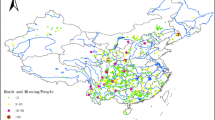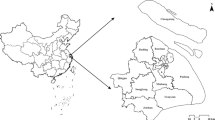Abstract
This study examines the spatiotemporal evolution of China’s flash flood disasters (FFDs) since 1949 and explores driving factors affecting the spatial distribution of historical FFDs. Records of more than 60000 FFDs are examined, and the centroid comparison method is used to reveal the spatiotemporal evolution of FFDs from 1951 to 2015. In particular, the geographical locations of the centroids, degrees of aggregation, and associated movement tendencies are examined to conduct a preliminary analysis of correlations between rainfall, population, and the spatiotemporal evolution of FFDs. Subsequently, using relevant data from 2000 to 2015, three factors relating to FFDs in natural watershed units include namely rainfall, human activity, and the environment of the Earth’s surface. The geographical detector method is then employed to explore the effect of these driving factors on the spatial distribution of FFDs. Analysis results show that displacement of the spatial distribution of FFDs since 1949 is correlated with variations in rainfall and population distribution. In addition, it is determined that the distribution of FFDs occurring between 2000 and 2015 have regional differentiation characteristics. However, the effect of rainfall on the distribution of FFDs is more significant than that of human activity or the environment of the Earth’s surface, but interactions occur between these latter two factors in disaster-formative environments. Furthermore, results also show that the driving factors of FFDs have significant spatiotemporal heterogeneity. In China, regions at high risk of FFDs include the Sichuan-Chongqing ecological zone, the South China ecological zone, the Yunnan-Guizhou Plateau, and the middle and lower reaches of the Yangtze River, while regions with a low risk of FFDs include the Northwest China arid zone, Qinghai-Tibet Plateau, Inner Mongolian Plateau, and the Northeast China ecological zone. These findings support further studies investigating disaster-formative environments, facilitate FFD risk zoning, and provide a scientific basis for plans to effectively prevent and control FFDs.
Similar content being viewed by others
References
Chen F H, Huang W, Jin L Y, Chen J H, Wang J S. 2011. Spatiotemporal precipitation variations in the Arid Central Asia in the context of global warming. Sci China Earth Sci, 54: 1812–1821
Cui P, Su F H, Zou Q, Chen N S, Zhang J L. 2015. Risk assessment and disaster reduction strategies for mountainous and meteorological hazards in Tibetan plateau (in Chinese with English abstract). Chin Sci Bull, 60: 3067–3077
Cui P. 2014. Progress and prospects in research on mountain hazards in China (in Chinese with English abstract). Progress Geography, 33: 145–152
Cui Y, Kong J M, Tian S J, A F Y. 2011. The critical role for heavy rainfall in the evolution of the mountain hazards chains (in Chinese with English abstract). J Mountain Sci, 29: 87–94
Du J, Ding W F, Ren H Y. 2015. Relationships between different types of flash flood disasters and their main impact factors in the Sichuan Province (in Chinese with English abstract). Res Environ Yangtze Basin, 24: 1977–1983
Fan J, Tao A J, Lv C. 2010. The coupling mechanism of the centroids of economic gravity and population gravity and its effect on the regional gap in China (in Chinese with English abstract). Prog Geogr, 29: 87–95
Fang Y P, Chen G J. 2003. Human activity response and prevention strategy of soil erosion in Sichuan Province (in Chinese). Sci China Ser E-Tech Sci, 33: 47–60
Fu B J, Liu G H, Ouyang Z Y. 2013. Research of China Ecological Regionalization (in Chinese). Beijing: Science Press. 137
General Administration of Quality Supervision, Inspection and Quarantine of the People’s Republic of China, China National Standardization Management Committee. 2008. Comprehensive control of soil and water conservation: General rule of planning (GB/T 15772-2008) (in Chinese). Beijing: Standards Press of China. 21
General Administration of Quality Supervision, Inspection and Quarantine of the People’s Republic of China, China National Standardization Management Committee. 2012. Grade of Precipitation (GB/T 28592-2012) (in Chinese with English abstract). Beijing: Standards Press of China
Guo L, Liu C J, Ding L Q, Sun D Y. 2012. Proposal of research and evaluation of mountain flood disaster nationwide (in Chinese with English abstract). China Water Resour, 23: 10–12
Hallegatte S. 2014. Modeling the role of inventories and heterogeneity in the assessment of the economic costs of natural disasters. Risk Anal, 34: 152–167
Hu H Y. 1935. Population distribution with statistical table and density graphic (in Chinese). Acta Geogr Sin, 2: 33–74
Jin L Y, Li J, Wang X, Chen F H. 2004. The temporal and spatial distribution conditions over Northwestern China of surface dry-wet in recent 50 years (in Chinese with English abstract). Acta Geogr Sin, 59: 847–854
Lian J J, Yang W C, Xu K, Ma C. 2017. Flash flood vulnerability assessment for small catchments with a material flow approach. Nat Hazards, 88: 699–719
Liu J Y, Liu M L, Fang D Z, Zhang Z X, Deng X Z. 2002. Spatial analysis of land use change in recently China (in Chinese). Sci China Ser DEarth Sci, 32: 1031–1040
Liu Y S, Yuan X M, Guo L, Huang Y H. 2017. Driving force analysis of the temporal and spatial distribution of flash floods in Sichuan Province. Sustainability, 9: 1527
Liu Y S, Li J T. 2017. Geographic detection and optimizing decision of the differentiation mechanism of rural poverty in China (in Chinese with English abstract). Acta Geogr Sin, 72: 161–173
Liu Y, Yang Y. 2012. Major natural disasters and their spatio-temporal variation in the history of China. J Geogr Sci, 22: 963–976
Liu Z Y, Yang D W, Hu JW. 2010. Dynamic critical rainfall-based torrential flood early warning for medium-small rivers (in Chinese with English abstract). J Beijing Normal Univ-Nat Sci, 46: 317–321
Lü Y Z, Li B G. 2006. Agrology (in Chinese). Beijing: China Agriculture Press. 26–29
Ord J K, Getis A. 1995. Local spatial autocorrelation statistics: Distributional issues and an application. Geogr Anal, 27: 286–306
Rozalis S, Morin E, Yair Y, Price C. 2010. Flash flood prediction using an uncalibrated hydrological model and radar rainfall data in a Mediterranean watershed under changing hydrological conditions. J Hydrol, 394: 245–255
Sangati M, Borga M. 2009. Influence of rainfall spatial resolution on flash flood modelling. Nat Hazards Earth Syst Sci, 9: 575–584
Schröder D, Omran A. 2015. Automated geoprocessing workflow for watershed delineation and classification for flash flood assessment. Int J Geoinform, 11: 31–38
Shi P J, Kong F. 2016. Research on related factors to decadal accumulated heavy rainfall spatio-temporal patterns change in China during 1951–2010 (in Chinese with English abstract). Sci Geogr Sin, 36: 1457–1465
Špitalar M, Gourley J J, Lutoff C, Kirstetter P E, Brilly M, Carr N. 2014. Analysis of flash flood parameters and human impacts in the US from 2006 to 2012. J Hydrol, 519: 863–870
Sun D Y, Zhang D W, Cheng X T. 2012. Framework of national Non- Structural measures for flash flood disaster prevention in China. Water, 4: 272–282
Sun J, Zhang F Q. 2017. Daily extreme precipitation and trends over China. Sci China Earth Sci, 60: 2190–2203
Tang C, Zhu J. 2005. A GIS based regional torrent risk zonation (in Chinese with English abstract). Acta Geogr Sin, 60: 87–94
Wan S Y, Zhao N K, Duan W. 2015. Correlation and multi-time scale characteristic of the strong precipitation and the land-slide debris flow in Yunnan Province (in Chinese with English abstract). J Catastrophol, 30: 45–50
Wang J F, Li X H, Christakos G, Liao Y L, Zhang T, Gu X, Zheng X Y. 2010. Geographical detectors-based health risk assessment and its application in the neural tube defects study of the Heshun Region, China. Int J Geogr Inf Sci, 24: 107–127
Wang J F, Xu C D. 2017. Geodetector: Principle and prospective (in Chinese with English abstract). Acta Geogr Sin, 72: 116–134
Wu X, Huang W, Chen F H. 2014. Construction and application of monthly air temperature and precipitation gridded datasets with high resolution (0.0250×0.0250) over China during 1951–2012 (in Chinese with English abstract). J Lanzhou Univ-Nat Sci, 72: 116–134
Yang G G, Yang Y Z, You Z, Zhang X Y. 2011. The Temporal and spatial distribution pattern of earthquake disaster in Chinese mainland (in Chinese with English abstract). Adv Earth Sci, 26: 548–555
Yang X H, Liu Y S, Jiang D, Luo C, Huang Y H. 2006. An enhanced method for spatial distributing census data: Re-classifying of rural residential (in Chinese with English abstract). Progr Geogr, 25: 62–69
Yuan Q Z, Wu S H, Dai E F, Zhao D S, Zhang X R, Ren P. 2017. Spatiotemporal variation of the wet-dry conditions from 1961 to 2015 in China. Sci China Earth Sci, 60: 2041–2050
Yuan X M, Liu Y S, Huang Y H, Tian F C. 2017. An approach to quality validation of large-scale data from the Chinese Flash Flood Survey and Evaluation (CFFSE). Nat Hazards, 89: 693–704
Zhang G P, Zhao L N, Xu F W, Xu X L. 2010. Study on basin partition scheme of China based on basin structure analysis (in Chinese with English abstract). J Beijing Normal Univ-Nat Sci, 46: 417–423
Zhao G, Pang B, Xu Z X, Wang Z F, Shi R. 2016. Assessment on the hazard of flash flood disasters in China (in Chinese with English abstract). J Hydraul Eng, 47: 1133–1142
Zhao J, Fan B L. 2006. Characteristics of temporal and spatial distribution of mountain flood in China (in Chinese with English abstract). China Water Res, 13: 45–47
Zhao S J. 2016. Secondary discussion on spatial and temporal scale of natural disaster risk (in Chinese with English abstract). J Catastrophol, 31: 1–10
Acknowledgements
This work was supported by the Strategic Priority Research Program of the Chinese Academy of Sciences (Grant No. XDA19040402), the China National Flash Flood Prevention Project (Grant No. 126301001000150068), the Early Career Talent Program of Chinese Academy of Sciences ‘Youth Innovation Promotion Association of Chinese Academy of Sciences’ (Grant No. 2014042), the Kezhen Talent Program of IGSNRR, CAS (Grant No. 2016RC101), the Research on Spatio-Temporal Variable Source Runoff Model and its Mechanism (Grant No. JZ0145B2017), and the projects of Application of Remote Sensing on Water and Soil Conservation in Beijing (Grant No. Z161100001116102).
Author information
Authors and Affiliations
Corresponding author
Rights and permissions
About this article
Cite this article
Liu, Y., Yang, Z., Huang, Y. et al. Spatiotemporal evolution and driving factors of China’s flash flood disasters since 1949. Sci. China Earth Sci. 61, 1804–1817 (2018). https://doi.org/10.1007/s11430-017-9238-7
Received:
Revised:
Accepted:
Published:
Issue Date:
DOI: https://doi.org/10.1007/s11430-017-9238-7




